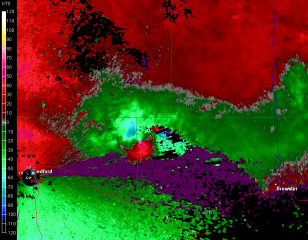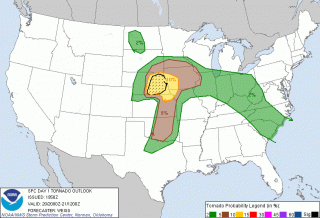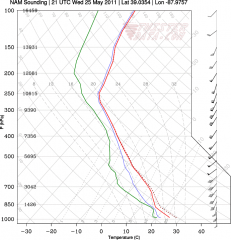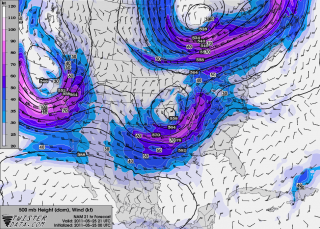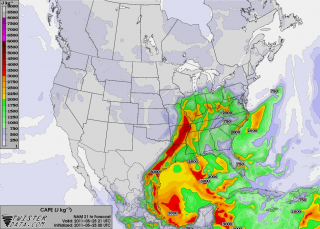Michigan is not Oklahoma. It is not even Illinois. If you’re a storm chaser who has any life experience with this state, as a few of you do besides me, you know exactly what I mean. Had Dorothy and Toto lived here instead of in Kansas, The Wonderful Wizard of Oz would never have been written. That or else author L. Frank Baum would have had to find a dfferent means of lofting his main character and her little dog somewhere over the rainbow.
Sure, Michigan gets its annual tally of tornadoes. It’s just that most of them are something less than what you’ll encounter west of the Mississippi or down south in Dixie Alley. That’s not a bad thing, given our population density. But it does require Michigan-based chasers to either travel long distances out of state or else languish from convective malnutrition.
You want to see a Michigan tornado? Okay, I’ll show you a Michigan tornado. But be forewarned, it’s not a pretty sight. It’s barely any kind of a sight at all. When I first spotted it, I wasn’t even certain it was a tornado, though after reviewing my HD clip and getting a couple of other reliable opinions, I’m now convinced. Good thing, too, because it’s all I’ve got to show for this year in terms of actually seeing a tornado. That’s pretty pathetic, considering the chase opportunities that circum 2011 has presented. But you can’t chase when your 85-year-old mother is having a knee replacement, as mine did on April 27, the day of the 2011 Super Outbreak; or when you just don’t have the money to go gallivanting freely across Tornado Alley, a reality that has badly limited me this year.
Given such circumstances, you grab what you can, where you can, when you can. July 27 was an example. Although a light risk tapped on the very westernmost edge of Michigan, my state was for the most part outlooked for nothing more than general thunderstorms. Severe weather wasn’t a concern. So imagine my surprise when I spotted distinct rotation on GR3 in a cell just to my southwest, heading ESE toward Hastings.
Grabbing my gear, I hopped in my car and headed east, setting up my laptop on the way. And what do you know! The radar didn’t lie. The storm had a large, well-defined wall cloud that I caught up with as I approached Hastings on State Road.
Since my video clip doesn’t show much in the way of structure, let me assure those of you who care about such things that this storm had good visual clues: impressive wall cloud, crisp updraft tower, and a warm RFD cascading off the back end. As I’ve already mentioned, storm motion was ESE, which corroborates my recollection of a northwest flow regime and explains why the rotation was more on the northwest part of the cell than the southwest. Also, as I recall, surface winds were from the SSW, though I can’t say how they were behaving ahead of the updraft area as I never managed to outpace the storm.
With all that said, here’s what happens in the video: Heading south behind the storm, I first spot the tornado out of my side window, which is covered with raindrops. Those somewhat obscure the funnel, but you can still make it out as a small, faint, whitish blotch connecting the cloud base to the treeline a little ways to the right of center. At this point I’m debating with myself and conclude that the feature is just scud. I park the car, zoom in on the storm and lose focus, then roll down the window and zoom back out. You’ll then see a small sapling mid-screen, and the tornado still barely visible to its right as a tiny strand of light gray condensation set against the darker background. It, translates almost imperceptibly to the right for a handful of seconds before vanishing. In my HD clip, I can make out something of an actual rope-out, but you can’t tell with YouTube.
Nevertheless, even though YouTube isn’t great for detail, I think you’ll see what I’m talking about overall. I promise you, it’s there; you just have to look closely. And use your imagination. And be highly suggestible. And believe in the Tooth Fairy. (I’ve also got some clips of Sasquatch and the Loch Ness monster that you may take an interest in, but those are for another time.)
The tornado doesn’t appear in the day’s storm reports, and I don’t believe the supercell that produced it ever got severe-warned. I think I was the only chaser on the darn thing, at least from my side of the state. I did report the wall cloud to GRR. I never bothered with the tornado because it was there and gone before I’d made up my mind what it was. It certainly was an anemic little puke, and I’m not sure whether to feel grateful that I scored at least one tube this year or to feel mortified about even claiming it. I almost felt sorry for the poor thing, and if I could have, I’d have taken it home and cared for it until it was healthy, and then released it under some nice, beefy updraft tower while strains of “Born Free” played in the background.
Go ahead and laugh, but I’m probably the only chaser in Michigan who got video of this tornado. Then again, that’s nothing to brag about, particularly in a year when so many chasers have captured videos of violent, mile-wide monsters. It’s just, like I said, all I’ve got to show. Yeah, I was there with my buddies right by the airport when the April 22 Saint Louis tornado hit, but none of us actually saw a funnel. I doubt anyone did after dark in all that rain. So July 27 is it for me, my sole visual record. Mine, all mine. Bob’s tornado. I’ve assigned it an F6 on the original Fujita scale, F6 being a hypothetical rating associated with “inconceivable damage.” That description fits perfectly, as this tornado was practically hypothetical, and it’s inconceivable to me that it could have damaged much of anything. Maybe snatched up an ill-fitting toupee, but that’s about it.
So there you have it: a genuine Michigan tornado. Now you know what storm chasing is like here in my state. It’s just another of the great perks that this supercell haven has to offer besides its economy.
I will say this: we do have fantastic craft beer.

